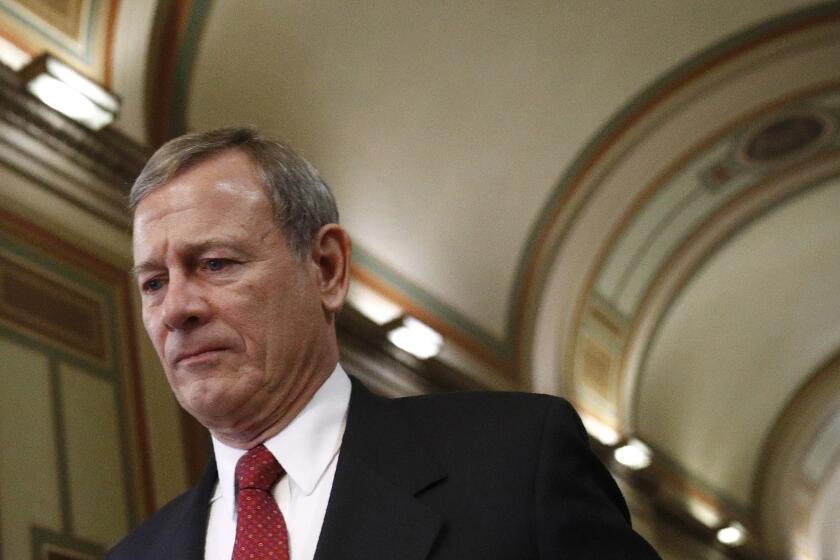A Legacy of Bitterness : Navajo-Hopi Land Dispute a Century of Pain
- Share via
MOSQUITO SPRINGS, Ariz. — Betty Tso still dreams of returning to this hauntingly remote spot where she was born--to the spot where her placenta and those of her grandmother and mother are buried, as is the Navajo way.
But she cannot return to the peaceful Blue Canyon area where she was reared, or to the life of herding cattle, slaughtering sheep and sleeping in a mud hogan. Instead, she lives in a trailer park with her two small children in drab Tuba City, 45 miles to the west. She works in a law office.
This is not her doing. She is caught up in a dispute that began more than a century ago, when the U.S. government partitioned the land between the Navajos and the Hopis, eventually displacing thousands of Navajos.
The results have been tragic. The largest group of civilians moved since the Japanese Americans in World War II, the relocated Navajos suffer astounding alcoholism, suicide and unemployment rates--far higher than those of other Navajos. This is the legacy for those wrenched from their traditional lives on this brutally barren, rugged territory in northern Arizona.
And as the Hopis and Navajos were thrust into the non-Native American world of borders and land ownership, something else developed--the tribes, which had lived together in the Southwest for centuries before the white man arrived, became enemies.
“My mom used to tell stories about what it was like before the dispute, when the Navajos and Hopis used to trade a lot and spend days together at ceremonies,” the 32-year-old Tso said with a sigh. “But people my age don’t have relations like that. I was born and raised with the land dispute, so that’s all I know.”
The question of who is to blame consumes families like the Tsos. For decades, their lives have been contorted by court appeals, demonstrations and other turmoil as they fought the Hopis over livestock and land rights.
History faults the federal government, which partitioned the land to make way for mining interests; the Hopi and Navajo governments, which rubber-stamped the borders so the tribes could share in the profits; and the people, who allowed their leaders to divide them.
This fall, Congress passed legislation aimed at ending the bitter fight. But for the tribes, solutions may come too late: The ugly feud is now part of their landscape, as evident and enduring as the magnificent red rock canyons and endless desert mesas.
It has been there since 1882, when President Chester Arthur approved the first Hopi reservation borders. The idea was to keep Native Americans away from white settlers and to keep proselytizing Mormons away from Native Americans.
*
The question of who controlled northern Arizona became more important as more settlers moved west and it was discovered that the area held some of the continent’s richest mining deposits. Energy companies, anxious to negotiate for the right to mine, pressured the government to establish clear boundaries and governance. The Navajo and Hopi reservations, as well as their governmental bodies, were created by U.S. officials ignorant of Native American ways.
As the scope of the profits at stake became clear, there was disagreement within both tribes over what to do. Native Americans who were open to mining and development filled the new legislative posts and approved lucrative deals with energy companies. To this day, both tribes rely on profits from Peabody Western Coal Co. for much of their budgets.
As partitioned by the federal government, the 1.6-million-acre Hopi reservation sits in the center of the Navajos’ 17 million acres. The Navajo Nation is the country’s largest Indian reservation, straddling Arizona, Utah, Colorado and New Mexico.
Most of the 250,000 Navajos do not live near the Hopis and are typically inactive in the dispute. But some live over the border lines, and their fate in an area where both tribes claim a historic right has been at issue.
Finally, in the mid-1970s, the federal courts and Congress drew a line and ordered everyone on the wrong side--primarily Navajos--to move.
The last two decades have seen more than 2,000 Navajo families moved. The years were marked with protests, demonstrations and Navajo grandmothers waving shotguns as Hopi rangers seized their livestock and tore down their hogans.
Eventually, most acquiesced, relocating at government expense to new, modern homes far from their native lands. But there are those who could not be moved.
Among those last, stubborn resisters are Minnie Grace Smith and her brother, David Begody. Minnie has passed nearly 100 winters and David about 80 at Willow Springs, a wind-whipped plateau west of Mosquito Springs.
*
Like 250 other families who have resisted moving, they are barred by law from fixing or expanding anything until the dispute is resolved. Refusing to leave, they and 15 of their descendants cram into a decrepit hogan and a trailer.
Talk these days revolves around the new legislation, which creates leases acknowledging the land is Hopi in exchange for the right to stay. The Navajo resisters have until March 31 to sign or be forced to leave.
“The elders don’t want to live under the Hopi, but being away from the land, away from the ceremonies, they get spiritually sick,” Begody’s daughter, Betty James, said in Navajo. He sat beside her, staring blankly out the hogan door across the endless horizon.
A tired-looking 55, James said the dispute has gradually undermined once-neighborly relations between the Navajos and the Hopis. Now, she said, when she goes to the nearby Hopi town of Hotevilla for mail and groceries, people sneer.
“When we see a Hopi we get mad, or when they see us, they get mad,” she said. “Because of the government, there are a lot of differences between us now.”
For Hopis and Navajos who don’t live near the disputed land, the bitter feud seems irrelevant.
“These kids could care less about race,” Tuba City High School Principal Leroy Shingoitewa said of students in the highly integrated Navajo town. “If they get into it, it’s because of someone’s girlfriend.”
A Navajo and a Hopi kissing outside the school giggle and look confused when asked if their different backgrounds cause problems. In the halls students mingle, indistinguishable from one another in the global adolescent uniform of jeans and T-shirts. Their parents work side by side in hospitals and health clinics; some intermarry.
There are many who live this way, unfettered by the dispute.
“What’s sad is that the two tribes should be on the same side,” said Peterson Zah, Navajo tribal chairman from 1983-1987 and its president from 1991-1994.
They have much in common, Zah said. For example, for much of the century both were forced by the federal government to send their children to white boarding schools far away. Now many young people reject traditional life altogether, opting to leave the reservation for nearby cities.
“There was once a lot of cooperation between the people,” Zah said. “But since the federal government violated the land, in the back of everybody’s mind is going to be that land dispute.”
There is an underlying reason why the land dispute has survived dozens of lawsuits, cost years, lives and some $500 million for the U.S. government alone. Despite areas of collaboration, there are fundamental prejudices between the tribes, real questions of who has the spiritual right to the land.
A deeply religious and rigid people, traditional Hopis believe they are “spiritual stewards” of a land they arrived on more than 1,000 years ago. They pass along stories of the Navajo arrival in the 1500s, belittling them for their more flexible approach to tradition.
“With the Navajos, these powwow dances are suddenly all over the place, when they really have no roots here,” said Leigh Jenkins, director of cultural preservation for the Hopi tribe.
“In order to settle here, Hopis had to earn the privilege. Only a few of the many tribes who came to the Americas earned that right.”
An amalgam of wandering Indian and non-Indian groups, the Navajo have historically been more adaptable, embracing customs of the Pueblo and Apache--among others--and integrating horses and sheep into their economy. While the Hopis built stone villages atop the mesas, the Navajos spread out their mud hogans in canyons and valleys.
In the eyes of the Navajo, the stereotypical Hopi is arrogant.
“The Hopis are two-faced,” said Nora James, Betty James’ 30-year-old daughter from Willow Springs. “They’ll be friendly to you and then turn around and stab you in the back.”
For many who grew up with the land dispute, there will be no reconciliation.
For now, both tribes await the deadline of March 31, watching as the white man who divided them pressures them to come together. The lure of peace is enough for some.
“I don’t want my children growing up knowing there’s a difference between Navajo and Hopi. I want them only to know that this ugly period in history is over,” said Tso. Once a radical resister, she now supports legislation she believes will return her to Mosquito Springs.
“After all,” she said softly, “the land doesn’t belong to the Navajo or to the Hopi. It belongs to the creator.”
More to Read
Sign up for Essential California
The most important California stories and recommendations in your inbox every morning.
You may occasionally receive promotional content from the Los Angeles Times.










